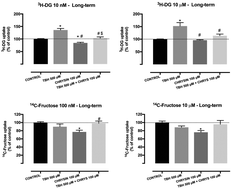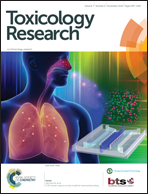The effect of oxidative stress upon intestinal sugar transport: an in vitro study using human intestinal epithelial (Caco-2) cells
Abstract
The pathogenesis of various gastrointestinal diseases, including gastrointestinal cancers and inflammatory bowel disease, is associated with increased oxidative stress levels. We aimed to investigate the effect of oxidative stress induced by tert-butylhydroperoxide (TBH) on the uptake of 3H-deoxy-D-glucose (3H-DG) and 14C-fructose by the human intestinal Caco-2 cell line. TBH (500 μM; 24 h) increased lipid peroxidation (TBARS) levels and was not cytotoxic. TBH (500 μM; 24 h) increased uptake of both low (SGLT1-mediated) and high concentrations (SGLT1- and GLUT2-mediated) of 3H-DG, but did not affect absorption of 14C-fructose (GLUT2- and GLUT5-mediated). The polyphenol chrysin abolished the increase in TBARS levels and the increase in uptake of both low and high concentrations of 3H-DG induced by TBH. On the other hand, TBH blocked the inhibitory effect of chrysin on 14C-fructose uptake. 3H-DG uptake, but not 14C-fructose uptake, was sensitive to sweet taste receptor (STRs) inhibition (with lactisole). The inhibitory effect of lactisole in relation to uptake of 3H-DG (10 nM) (SGLT1-mediated), but not in relation to uptake of 3H-DG (50 mM) (SGLT1- and GLUT2-mediated), was abolished in the presence of TBH. So, these results show that the stimulatory effect of STRs on SGLT1-mediated transport is dependent on oxidative stress levels. In conclusion, this work shows that uptake of both 3H-DG and 14C-fructose is sensitive to oxidative stress levels. Moreover, it suggests that the three distinct transporters involved in the intestinal absorption of glucose and fructose (SGLT1, GLUT2 and GLUT5) have different sensitivities to oxidative stress levels, SGLT1 being the most sensitive and GLUT5 the least.



 Please wait while we load your content...
Please wait while we load your content...